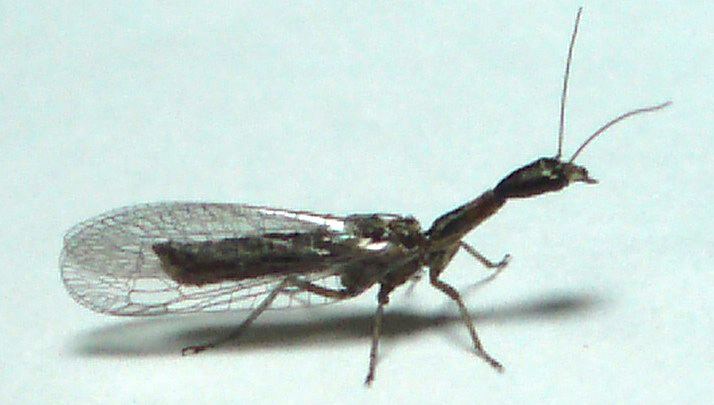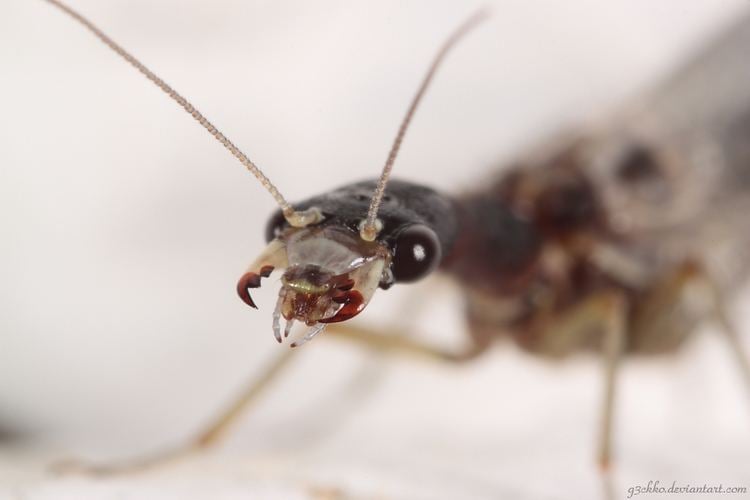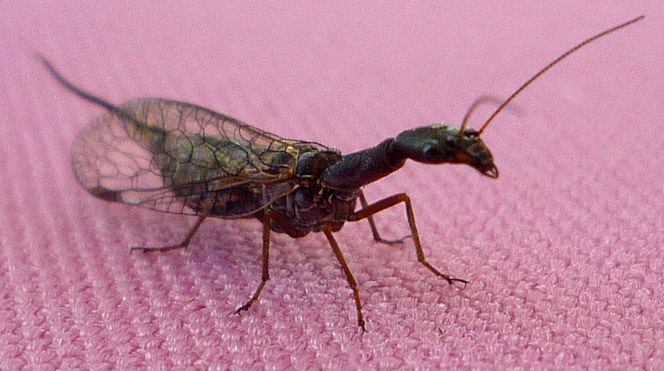Scientific name Raphidioptera Higher classification Insect | ||
 | ||
Similar Raphidiidae, Megaloptera, Neuropterida | ||
Snakefly super macro
Snakeflies are a group of insects comprising the order Raphidioptera, which is divided into two families: Raphidiidae and Inocelliida consisting of roughly 260 species. Together with the Megaloptera they were formerly placed within the Neuroptera, but now these two are generally regarded as separate orders. Members of this order have been considered living fossils, as the phenotype of a species from the early Jurassic period (140 million years ago) closely resembles modern-day species.
Contents
- Snakefly super macro
- Snakefly subilla confinis 2015 06 20
- Anatomy and life cycle
- Habitat and Species Distribution
- Predators and Parasitism
- Pest Control
- Distinguishing taxonomic features
- Taxonomy
- References

The order'S name, Raphidioptera, is derived from the Greek "raphio", which means needle, and "ptera", which means wing.
Snakefly subilla confinis 2015 06 20
Anatomy and life cycle

Adult snakeflies are characterized by having an elongate prothorax but no modification of the forelegs (as in Mantispidae). They have strong and relatively unspecialised mouthparts, and large compound eyes. Some species also have ocelli. The females typically have a long ovipositor, which they use to deposit their eggs into crevices in bark or rotting wood. The two pair of dragonfly-like wings are similar in size, with a primitive venation pattern, and a thickened costal margin (or "pterostigma").

The larvae have large heads with projecting mandibles. The head and the first segment of the thorax are sclerotised, but the rest of the body is soft and fleshy. They have three pairs of true legs, but no prolegs. However, they do possess an adhesive organ on the abdomen, which they can use to fasten themselves to vertical surfaces.

There is no set number of instars the larvae will go through, some species can have as many as 10-11. The larval stage usually takes around 2–3 years, but in some species can take as long as 6 years. The final larval instar creates a cell in which the insect pupates. The pupa is fully capable of movement, and often leaves its cell for another location before the adult emerges. All snakeflies require a period of cool temperatures (probably around 0 °C) to induce pupation. Depending on when the snakefly pupates determines the length of pupation, Most species pupate in the spring and can take a few days to 3 weeks. Some species seen in more tropical climates will pupate in the early summer and takes around 3 weeks before reaching adulthood. If the larvae begins pupation in the late summer or early fall it can take up to 10 months for pupation to complete.

Snakeflies are extremely territorial and carnivorous organisms. They have been known to be an important predator to aphids and mites. Pollen has also been found in the guts of these organisms and it is unclear whether they require pollen for part of their lifecycle or if they prefer that as a food source as well. The larvae are also predacious and even though no current studies have been done on diet selection by larvae it is thought that they potentially feed on eggs and larvae of other insect species.
Habitat and Species Distribution
Snakeflies are usually found in temperate coniferous forest. They are distributed widely around the globe: Europe and Asia, and can be found in certain regions of Africa, and western North America and Central America. In Africa they are only found in the mountains north of the Sahara Desert. In North America they are found west of the Rocky Mountains, and range from south west Canada all the way to the Mexican-Guatemalan Border which is the farthest south they have been found on the western hemisphere. In the eastern hemisphere, they can be found from Spain to Japan. Many species are found all throughout Europe and Asia with the southern edge of their range in northern Thailand and northern India. Even though there is a large distribution of this insect order, individual species distribution is often very limited and some species are confined to a single mountain range.
It was once thought that larvae were only found in the bark of trees, in part due to females' long ovipositor. Besides tree bark, larvae have also been found in soil, detritus, and around the roots of trees or smaller shrubs. The eggs can absorb the nutrients through the soil or detritus before larvae hatch.
Predators and Parasitism
The main predators for snakeflies are wood foraging birds such as the tree creeper, great-spotted woodpecker, wood warbler, nuthatch, and dunnock. The collared fly catcher which is a generalist forager, has also been known to feed on snakeflies. These are the only bird species that have been observed feeding on this species, but very little research has been done looking at the predators of snakeflies.
The insect order Hymenoptera is the largest group known to parasitize snakeflies; parasitized individuals are infected with hymenopteran 90-95% of the time it is from Hymenoptera. However, on average 5-15% of the snakefly larvae are parasitized but has been as high as 50% in some species.
Pest Control
This order of insects has been considered a viable option in agriculture use. The main advantages to have this species as a pest control agent is that there are not many known predators to the species, and both adults and larvae are predacious. Some of the disadvantages is that snakeflies undergo a long larval period meaning it could take a long time to completely rid the crops of pest.
Distinguishing taxonomic features
The morphological characteristics which distinguish the order Raphidioptera from other insect orders are as follows :
Taxonomy
The Megaloptera, Neuroptera (in the modern sense) and Raphidioptera are very closely related, forming the group Neuropterida. This is either placed at superorder rank, with the Endopterygota - of which they are part - becoming an unranked clade above it, or the Endopterygota are maintained as a superorder, with an unranked Neuropterida being a part of them. Within the endopterygotes, the closest living relatives of Neuropterida are the beetles.
There are four extinct families known only from fossils. Almost all known snakeflies belong to the suborder Raphidiomorpha. The exception being the Jurassic family Priscaenigmatidae, placed in suborder Priscaenigmatomorpha.
Extinct snakeflies are known from fossils dating from the Lower Jurassic to the Miocene.
Raphidioptera as grouped according to Engel 2002 with updates according to Bechly and Wolf-Schwenninger, 2011 and Ricardo Pérez-de la Fuente et al (2012):
Order Raphidioptera
